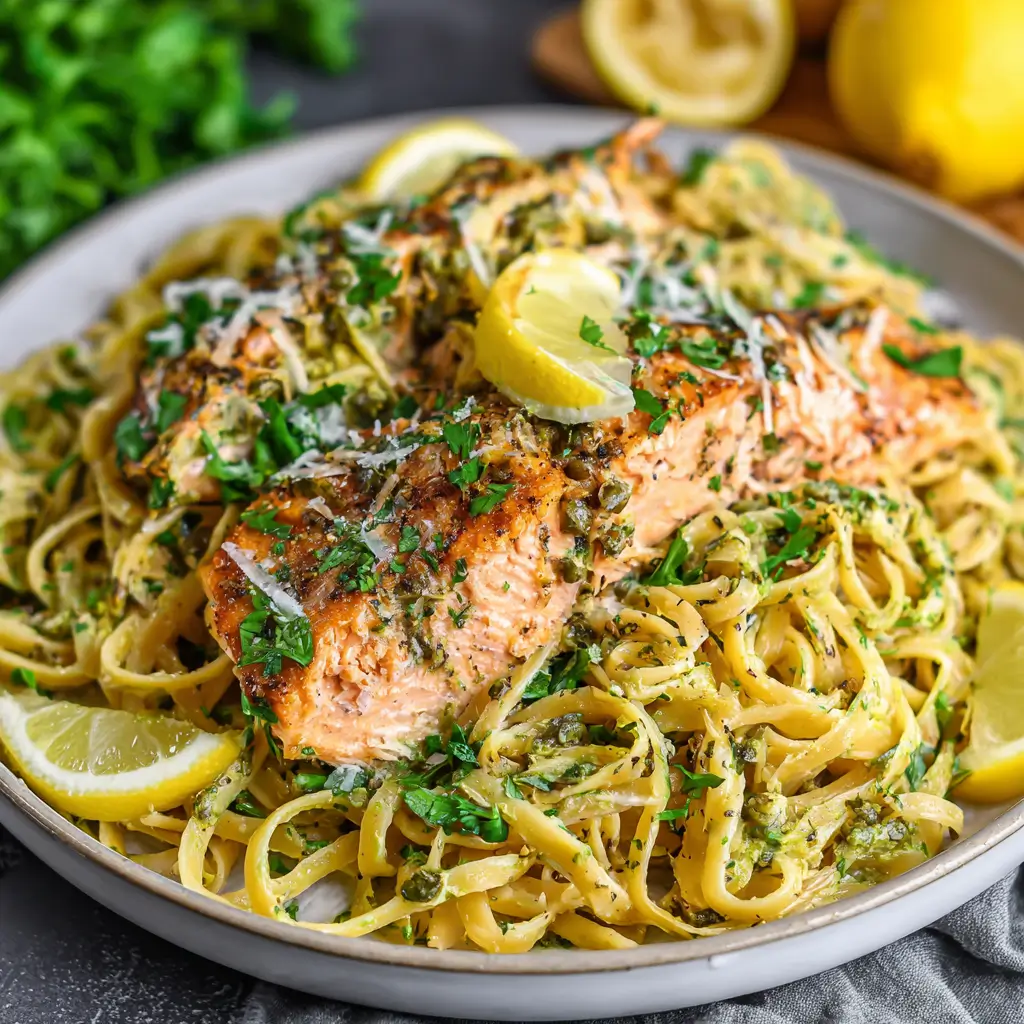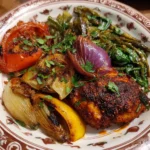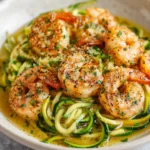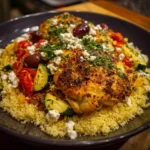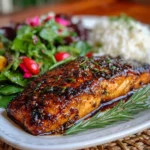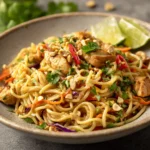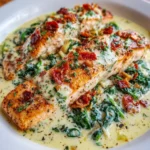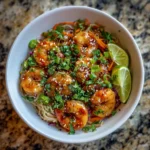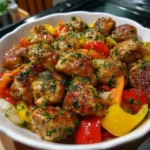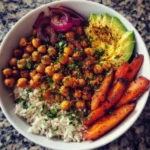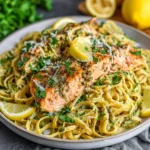Lemon Butter Herb Salmon Pasta: A Delightful Fusion of Flavors
Indulge in the rich, creamy elegance of Lemon Butter Herb Salmon Pasta—a dish that effortlessly marries the delicate flakiness of salmon with the bright zing of lemon, the richness of butter, and the aromatic depth of fresh herbs. This recipe is not just a meal; it’s a culinary experience that brings together comfort and sophistication on a single plate. Whether you’re preparing a romantic dinner for two, hosting a dinner party, or simply treating yourself to something special after a long week, this pasta dish delivers vibrant flavors, stunning presentation, and a nourishing balance of protein, healthy fats, and complex carbohydrates.
The History Behind the Dish
While there is no definitive historical origin for Lemon Butter Herb Salmon Pasta, its roots can be traced back to a confluence of culinary traditions—Mediterranean seafood cooking, French sauce techniques, and Italian pasta mastery. The use of salmon in pasta dishes became more prominent in the late 20th century as global palates embraced fatty fish like salmon for their flavor and health benefits. Classic French preparations often feature salmon with butter and lemon, such as saumon au beurre blanc, while Italian cuisine has long celebrated the union of pasta with fresh seafood and herbs.
The modern iteration of Lemon Butter Herb Salmon Pasta likely emerged from home cooks and chefs seeking to combine these traditions into a cohesive, restaurant-quality dish that could be made in a single skillet. With the rise of farm-to-table movements and an emphasis on fresh, seasonal ingredients, this recipe evolved to highlight high-quality salmon, locally sourced herbs, and artisanal pastas. Today, it stands as a testament to fusion cooking—where technique meets simplicity, and tradition dances with innovation.
Ingredients Breakdown
The magic of this dish lies in its carefully balanced ingredients, each playing a vital role in creating layers of flavor and texture. Here’s a detailed look at what goes into every bite:
- Salmon Fillets: Wild-caught Atlantic or Pacific salmon are ideal due to their rich omega-3 content and firm texture. The natural oils in salmon meld beautifully with the butter-based sauce, enhancing both flavor and mouthfeel.
- Pasta: Linguine or fettuccine are perfect choices because their flat surfaces hold onto the creamy sauce. Whole wheat or legume-based pastas can be used for added fiber and protein.
- Unsalted Butter: Provides a luxurious base for the sauce. Using unsalted butter allows better control over the salt level in the dish.
- Fresh Lemon: Both the juice and zest contribute a bright, citrusy tang that cuts through the richness of the butter and salmon. The acidity also helps tenderize the fish slightly during cooking.
- Garlic: Minced fresh garlic adds a pungent depth that complements both the salmon and herbs.
- Fresh Herbs: A combination of dill, parsley, chives, and thyme brings freshness and complexity. Dill pairs especially well with salmon, while parsley adds color and a mild peppery note.
- Shallot or Onion: Finely diced shallots offer a subtle sweetness and aromatic foundation without overpowering the dish.
- Dry White Wine: Optional but highly recommended—wine deglazes the pan and adds a nuanced acidity and fruitiness to the sauce.
- Heavy Cream or Half-and-Half: Adds silkiness to the sauce. For a lighter version, substitute with coconut milk or Greek yogurt.
- Olives or Capers (optional): These briny elements introduce a Mediterranean flair and contrast the buttery richness.
- Salt and Black Pepper: Essential seasonings to enhance all other components.
- Olive Oil: Used for searing the salmon and sautéing aromatics, adding another layer of fruity flavor.
- Red Pepper Flakes (optional): A pinch adds gentle heat and balances the overall profile.
Step-by-Step Recipe
- Prepare Ingredients: Start by gathering and prepping everything. Pat the salmon fillets dry with paper towels and season both sides with salt, pepper, and a squeeze of lemon juice. Zest one lemon and set aside; juice the remaining half. Mince garlic, dice shallot, and finely chop your herbs.
- Cook the Pasta: Bring a large pot of salted water to a boil. Add pasta and cook according to package instructions until al dente. Reserve 1 cup of pasta water before draining. Toss cooked pasta with a drizzle of olive oil to prevent sticking.
- Sear the Salmon: Heat 1–2 tablespoons of olive oil in a large skillet over medium-high heat. Place salmon fillets skin-side down (if applicable) and cook for 4–5 minutes until golden brown and crispy. Flip and cook for another 3–4 minutes until just cooked through. Remove from pan and flake into large chunks, discarding skin if desired.
- Sauté Aromatics: In the same skillet, reduce heat to medium. Add 1 tablespoon of butter, then sauté diced shallot until translucent (about 2 minutes). Add minced garlic and red pepper flakes; cook for 30 seconds until fragrant.
- Build the Sauce: Pour in ¼ cup of dry white wine (optional) and simmer for 1–2 minutes to reduce slightly. Stir in ½ cup heavy cream or half-and-half, followed by 3–4 tablespoons of butter, cut into pieces. Whisk until smooth and glossy.
- Add Citrus and Herbs: Stir in lemon zest, lemon juice, chopped dill, parsley, and chives. Season with salt and pepper to taste. Let the sauce simmer gently for 2–3 minutes to allow flavors to meld.
- Combine Pasta and Sauce: Add drained pasta to the skillet and toss thoroughly to coat. If needed, add reserved pasta water ¼ cup at a time to loosen the sauce and help it cling to the noodles.
- Incorporate Salmon: Gently fold in the flaked salmon, being careful not to break it up too much. Warm through for 1–2 minutes.
- Finish and Serve: Taste and adjust seasoning. Sprinkle with freshly cracked black pepper, extra herbs, and a final grating of lemon zest. Serve immediately while hot.
Tips for Perfect Lemon Butter Herb Salmon Pasta
- Don’t Overcook the Salmon: Salmon continues to cook slightly after removal from heat. Aim for medium-rare to medium doneness when searing, so it remains moist and tender when mixed into the pasta.
- Use Fresh Herbs: While dried herbs may work in a pinch, they lack the brightness and aroma of fresh ones. Always opt for fresh dill, parsley, and chives when possible.
- Reserve Pasta Water: The starchy liquid is essential for emulsifying the sauce and ensuring it clings perfectly to the pasta.
- Don’t Skip the Zest: Lemon zest contains potent essential oils that deliver intense citrus flavor without excess acidity.
- Control Sauce Consistency: If the sauce thickens too much upon standing, reheat gently and add warm pasta water or cream to restore creaminess.
- One-Pan Option: For fewer dishes, poach the salmon directly in the sauce using low heat and a lid, though this yields less crispness.
- Prevent Curdling: Avoid boiling the sauce vigorously after adding dairy. Keep heat at a gentle simmer to maintain a smooth texture.
- Season in Layers: Season each component—the salmon, the sauce, and the final dish—for balanced flavor throughout.
Variations and Customizations
This versatile recipe welcomes creativity and adaptation based on dietary needs, preferences, or available ingredients. Here are several delicious variations:
- Dairy-Free Version: Replace butter with vegan butter or olive oil, and use coconut cream instead of heavy cream. Nutritional yeast can add a cheesy depth.
- Gluten-Free Option: Use gluten-free pasta made from rice, corn, quinoa, or chickpea flour. Ensure all other ingredients (like broth or wine) are certified gluten-free.
- Low-Carb/Keto Adaptation: Swap pasta for spiralized zucchini (zoodles), spaghetti squash, or shirataki noodles. Increase healthy fats with avocado slices or toasted pine nuts.
- Seafood Medley: Add cooked shrimp, scallops, or mussels along with the salmon for a surf-and-turf effect.
- Vegetable Boost: Sauté spinach, cherry tomatoes, asparagus, artichoke hearts, or roasted bell peppers and mix them into the pasta.
- Creamy Avocado Twist: Blend ripe avocado into the sauce for a creamy, nutrient-dense alternative to dairy.
- Mediterranean Style: Incorporate kalamata olives, sun-dried tomatoes, capers, and crumbled feta cheese for a bold, tangy profile.
- Asian-Inspired Fusion: Swap dill and parsley for cilantro and green onions, add ginger, and finish with a splash of soy sauce or tamari and sesame oil.
- Smoked Salmon Upgrade: Use smoked salmon instead of fresh for a deeper, more robust flavor—ideal for brunch or appetizer versions.
- Herb Variations: Experiment with tarragon, basil, or mint depending on the season and your taste preferences.
Health Considerations and Nutritional Value
Lemon Butter Herb Salmon Pasta isn’t just delicious—it can be part of a balanced, nutritious diet when prepared thoughtfully. Here’s a breakdown of its key nutritional aspects:
- Omega-3 Fatty Acids: Salmon is one of the best sources of EPA and DHA, which support heart health, brain function, and reduce inflammation.
- High-Quality Protein: A 6-ounce serving of salmon provides about 34 grams of complete protein, aiding muscle repair and satiety.
- Healthy Fats: While butter and cream contribute saturated fat, pairing them with olive oil and omega-3s creates a more favorable fat profile.
- Vitamins and Minerals: Salmon is rich in vitamin D, B12, selenium, and potassium. Fresh herbs provide antioxidants, vitamin K, and phytonutrients.
- Complex Carbohydrates: Whole grain or legume-based pastas offer fiber, helping regulate blood sugar and support gut health.
- Low in Refined Sugars: Naturally free from added sugars, making it suitable for various dietary plans.
- Acidic Balance: Lemon juice aids digestion and enhances iron absorption from plant-based ingredients if added.
Dietary Modifications: To make the dish heart-healthier, reduce butter quantity and increase olive oil. Opt for low-fat dairy or plant-based alternatives. Limit sodium by using low-sodium broth and minimizing added salt. Pair with a side salad or steamed greens to boost fiber and micronutrient intake.
For those managing cholesterol, moderate cream and butter usage and emphasize the lean protein and unsaturated fats from salmon and olive oil. Pregnant individuals should ensure salmon is fully cooked and sourced responsibly to minimize mercury exposure.
Full Ingredient List
- 2 wild-caught salmon fillets (6 oz each), skin-on or skinless
- 8 oz linguine or fettuccine (whole wheat, gluten-free, or regular)
- 3 tbsp unsalted butter (divided)
- 2 tbsp olive oil (divided)
- 1 medium shallot, finely diced (or ¼ cup onion)
- 3 cloves garlic, minced
- ½ cup dry white wine (e.g., Sauvignon Blanc or Pinot Grigio) – optional
- ½ cup heavy cream or half-and-half (substitute coconut milk for dairy-free)
- Zest and juice of 1 large lemon (about 2 tbsp juice)
- ¼ cup fresh dill, chopped
- ¼ cup fresh parsley, chopped
- 2 tbsp fresh chives, sliced
- 1 tsp fresh thyme leaves (or ½ tsp dried)
- Salt and freshly ground black pepper, to taste
- Pinch of red pepper flakes (optional)
- 1 tbsp capers or sliced olives (optional)
- Reserved pasta water (up to 1 cup)
Detailed Directions
- Prep Work: Pat salmon dry and season lightly with salt, pepper, and 1 teaspoon lemon juice. Zest and juice the lemon. Chop all herbs and mince garlic. Measure out remaining ingredients.
- Boil Pasta: In a large pot, bring 4–6 quarts of water to a rolling boil. Add 1–2 teaspoons of salt and the pasta. Cook until al dente (usually 8–10 minutes). Before draining, reserve 1 cup of starchy cooking water. Drain and set aside.
- Sear Salmon: Heat 1½ tablespoons olive oil in a large non-stick or stainless steel skillet over medium-high heat. Once shimmering, add salmon fillets skin-side down (if present). Press gently with a spatula to ensure even contact. Sear for 4–5 minutes until skin is golden and crisp. Flip and cook for 3–4 minutes more, until salmon flakes easily with a fork. Transfer to a plate, flake into large pieces, and cover loosely with foil.
- Sauté Base: Reduce heat to medium. Add 1 tablespoon butter and ½ tablespoon olive oil to the same skillet. Add diced shallot and cook for 2–3 minutes until soft and translucent. Stir in garlic and red pepper flakes; cook for 30 seconds until fragrant.
- Deglaze Pan: Pour in white wine (if using) and let it bubble and reduce by half, about 1–2 minutes. Scrape up any browned bits from the bottom of the pan for maximum flavor.
- Create Sauce: Lower heat to medium-low. Stir in heavy cream, then begin adding butter one tablespoon at a time, whisking continuously until melted and incorporated. Do not boil rapidly—gentle simmer only.
- Add Citrus and Herbs: Stir in lemon zest, lemon juice, dill, parsley, chives, and thyme. Season with salt and pepper. Simmer for 2–3 minutes to thicken slightly and infuse flavors.
- Combine Pasta: Add drained pasta to the skillet and toss well to coat. Begin adding reserved pasta water ¼ cup at a time until sauce reaches desired consistency—creamy and silky, clinging to each strand.
- Fold in Salmon: Gently mix in flaked salmon, taking care not to break it apart completely. Heat through for 1–2 minutes. Taste and adjust seasoning—more lemon, salt, or herbs as needed.
- Serve Immediately: Plate the pasta, top with extra herbs, a sprinkle of lemon zest, cracked black pepper, and optional capers or olives. Serve hot with crusty bread or a simple arugula salad.
Frequently Asked Questions (FAQ)
Can I use frozen salmon?
Yes, but thaw it slowly in the refrigerator overnight for best texture. Never cook salmon from frozen in this recipe, as it will release too much water and affect the sauce.
Can I make this ahead of time?
It’s best served fresh, but you can prep components separately: cook pasta and chill with a little oil; sear salmon and refrigerate; make sauce base and reheat. Reassemble and warm just before serving.
What if I don’t have fresh herbs?
You can use dried herbs in reduced amounts (1 teaspoon dried = 1 tablespoon fresh), but the dish will lack vibrancy. Dill and parsley retain some flavor when dried, but chives and thyme are best fresh.
Is this recipe safe during pregnancy?
Yes, as long as the salmon reaches an internal temperature of 145°F (63°C) and is sourced from reputable suppliers to minimize contaminants.
Can I bake the salmon instead?
Absolutely. Bake at 400°F (200°C) for 12–15 minutes until flaky. Then proceed with the recipe. Baking yields moist fish but lacks the crisp skin.
How do I store leftovers?
Store in an airtight container in the refrigerator for up to 2 days. Reheat gently on the stove with a splash of water or broth to revive the sauce. Avoid microwaving, which can overcook the salmon.
Why did my sauce separate?
This usually happens due to high heat or adding cold ingredients. Always keep the sauce at a low simmer and ensure dairy is at room temperature before adding.
Can I freeze this dish?
Not recommended. Dairy-based sauces tend to separate upon freezing and reheating, and salmon becomes dry and mealy.
What wine pairs well with this dish?
A crisp white wine like Sauvignon Blanc, Pinot Grigio, or Chablis complements the lemon and herbs. For red lovers, a light Pinot Noir works well.
Can I use canned salmon?
Only if necessary. Choose high-quality, skinless, boneless canned salmon in water, drain well, and add at the end. Texture and flavor won’t match fresh, but it’s a budget-friendly option.
Summary
Lemon Butter Herb Salmon Pasta is a luxurious yet approachable dish that combines flaky salmon, al dente pasta, and a velvety lemon-herb sauce for a restaurant-worthy meal at home. Packed with omega-3s, fresh flavors, and customizable options, it’s perfect for weeknights, date nights, or impressing guests with minimal effort.
